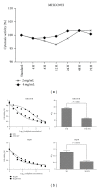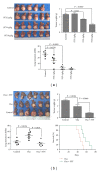Herbal Compound "Songyou Yin" Renders Hepatocellular Carcinoma Sensitive to Oxaliplatin through Inhibition of Stemness
- PMID: 23326293
- PMCID: PMC3541605
- DOI: 10.1155/2012/908601
Herbal Compound "Songyou Yin" Renders Hepatocellular Carcinoma Sensitive to Oxaliplatin through Inhibition of Stemness
Abstract
We investigated the effect of Chinese herbal compound Song-you Yin on HCC stemness. MHCC97H and Hep3B cell lines were pretreated with SYY for 4 weeks, and their chemosensitivity to oxaliplatin was evaluated. The expression of CSC-related markers, cell invasion and migration, and colony formation were also examined. SYY-treated orthotopic nude mouse models of human HCC were developed to explore the effect of oxaliplatin on tumor growth, metastasis, and survival. The CSC-related molecular changes in vivo were also evaluated. The result showed that MHCC97H and Hep3B cells pretreated with SYY showed significantly increased chemosensitivity to oxaliplatin and the downregulation of CSC-related markers CD90, CD24, and EPCAM. SYY also attenuated cell motility, invasion, and colony formation in MHCC97H and Hep3B cell lines. The reduced tumorigenicity and pulmonary metastasis were observed in SYY-pretreated cell lines. Combination treatment with oxaliplatin and SYY significantly reduced tumor volume and pulmonary metastasis and prolonged survival compared with oxaliplatin treatment alone. Immunohistochemical analysis showed reduced expression of CD90, ABCG2, ALDH, CD44, EPCAM, vimentin, and MMP-9 and increased the expression of E-cadherin, in HCC cells following combination treatment. These data clearly demonstrate that SYY renders hepatocellular carcinoma sensitive to oxaliplatin through the inhibition of stemness.
Figures





Similar articles
-
The herbal compound Songyou Yin (SYY) inhibits hepatocellular carcinoma growth and improves survival in models of chronic fibrosis via paracrine inhibition of activated hepatic stellate cells.Oncotarget. 2015 Nov 24;6(37):40068-80. doi: 10.18632/oncotarget.5313. Oncotarget. 2015. PMID: 26517671 Free PMC article.
-
Herbal Compound Songyou Yin and Moderate Swimming Suppress Growth and Metastasis of Liver Cancer by Enhancing Immune Function.Integr Cancer Ther. 2016 Sep;15(3):368-75. doi: 10.1177/1534735415622011. Epub 2015 Dec 22. Integr Cancer Ther. 2016. PMID: 26699805 Free PMC article.
-
Treatment with the herbal formula Songyou Yin inhibits epithelial-mesenchymal transition in hepatocellular carcinoma through downregulation of TGF-β1 expression and inhibition of the SMAD2/3 signaling pathway.Oncol Lett. 2017 Apr;13(4):2309-2315. doi: 10.3892/ol.2017.5700. Epub 2017 Feb 8. Oncol Lett. 2017. PMID: 28454396 Free PMC article.
-
Herbal compound "Songyou Yin" attenuates hepatoma cell invasiveness and metastasis through downregulation of cytokines secreted by activated hepatic stellate cells.BMC Complement Altern Med. 2013 Apr 27;13:89. doi: 10.1186/1472-6882-13-89. BMC Complement Altern Med. 2013. PMID: 23622143 Free PMC article.
-
Residual hepatocellular carcinoma after oxaliplatin treatment has increased metastatic potential in a nude mouse model and is attenuated by Songyou Yin.BMC Cancer. 2010 May 20;10:219. doi: 10.1186/1471-2407-10-219. BMC Cancer. 2010. PMID: 20487542 Free PMC article.
Cited by
-
Roles of conventional and complementary therapies in recurrent hepatocellular carcinoma.World J Gastrointest Oncol. 2023 Jan 15;15(1):19-35. doi: 10.4251/wjgo.v15.i1.19. World J Gastrointest Oncol. 2023. PMID: 36684056 Free PMC article. Review.
-
The herbal compound Songyou Yin (SYY) inhibits hepatocellular carcinoma growth and improves survival in models of chronic fibrosis via paracrine inhibition of activated hepatic stellate cells.Oncotarget. 2015 Nov 24;6(37):40068-80. doi: 10.18632/oncotarget.5313. Oncotarget. 2015. PMID: 26517671 Free PMC article.
-
ROS-Mediated Anti-Tumor Effect of Coptidis Rhizoma against Human Hepatocellular Carcinoma Hep3B Cells and Xenografts.Int J Mol Sci. 2021 Apr 30;22(9):4797. doi: 10.3390/ijms22094797. Int J Mol Sci. 2021. PMID: 33946527 Free PMC article.
-
Traditional Chinese medicine as supportive care for the management of liver cancer: Past, present, and future.Genes Dis. 2019 Nov 2;7(3):370-379. doi: 10.1016/j.gendis.2019.10.016. eCollection 2020 Sep. Genes Dis. 2019. PMID: 32884991 Free PMC article. Review.
-
Herbal Compound Songyou Yin and Moderate Swimming Suppress Growth and Metastasis of Liver Cancer by Enhancing Immune Function.Integr Cancer Ther. 2016 Sep;15(3):368-75. doi: 10.1177/1534735415622011. Epub 2015 Dec 22. Integr Cancer Ther. 2016. PMID: 26699805 Free PMC article.
References
-
- Jemal A, Bray F, Center MM, Ferlay J, Ward E, Forman D. Global cancer statistics. CA Cancer Journal for Clinicians. 2011;61(2):69–90. - PubMed
-
- Ye SL, Takayama T, Geschwind J, Marrero JA, Bronowicki JP. Current approaches to the treatment of early hepatocellular carcinoma. The Oncologist. 2010;15(supplement 4):34–41. - PubMed
-
- Bruix J, Sala M, Llovet JM. Chemoembolization for hepatocellular carcinoma. Gastroenterology. 2004;127:S179–S188. - PubMed
-
- El-Serag HB. Hepatocellular carcinoma. New England Journal of Medicine. 2011;365:1118–1127. - PubMed
-
- Carr BI. Hepatocellular carcinoma: current management and future trends. Gastroenterology. 2004;127(5, supplement 1):S218–S224. - PubMed
LinkOut - more resources
Full Text Sources
Miscellaneous

